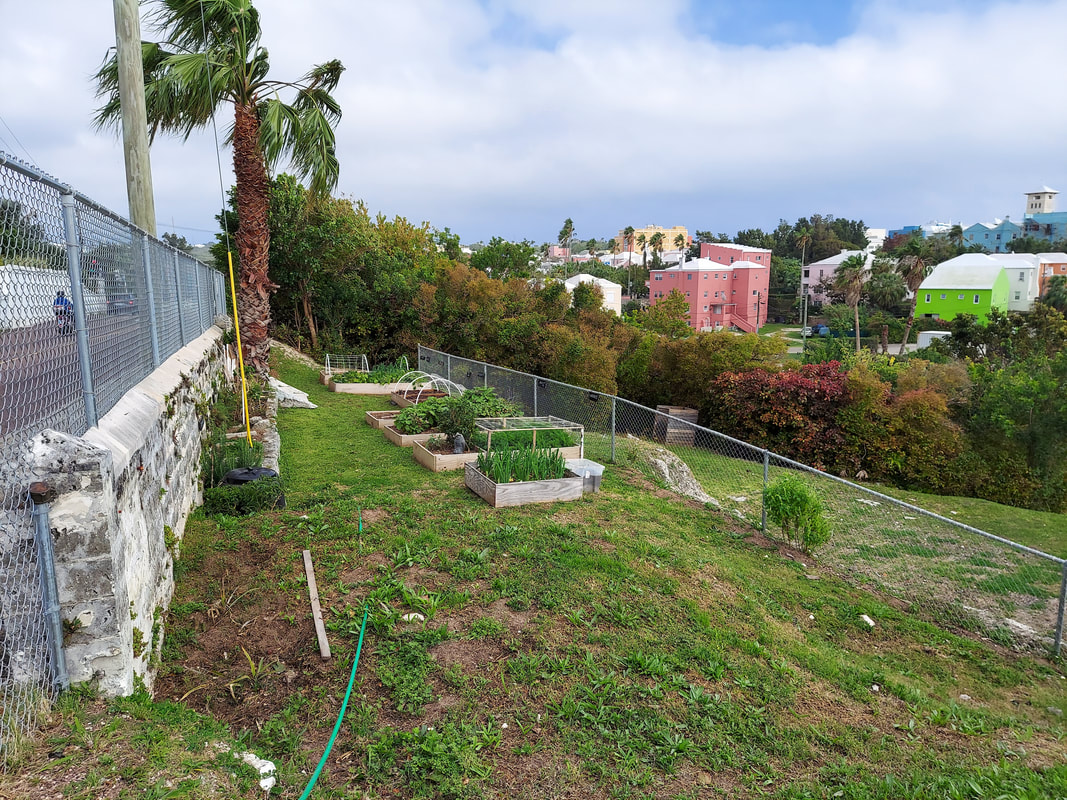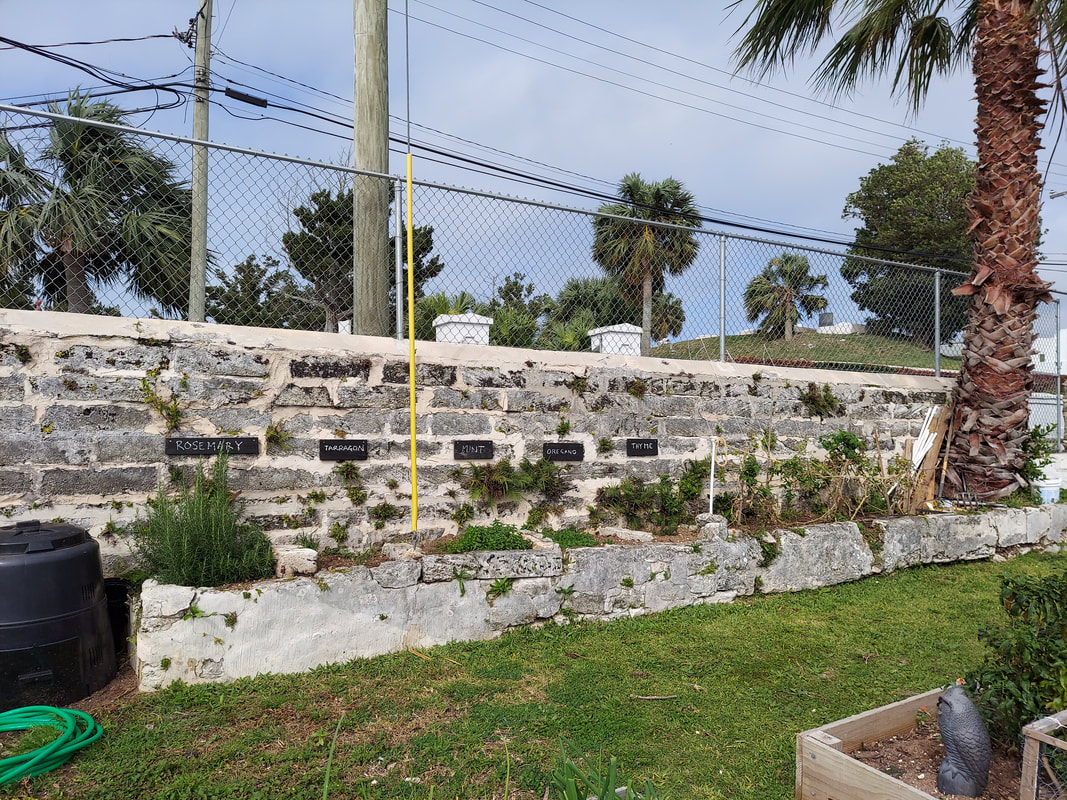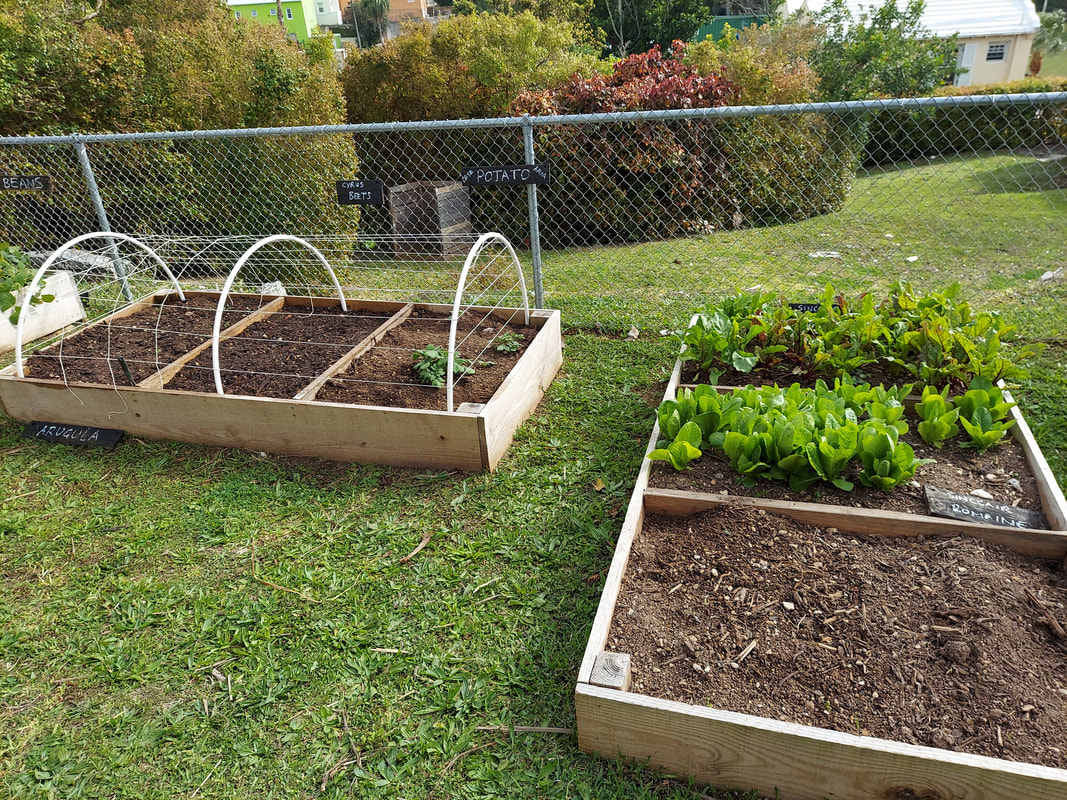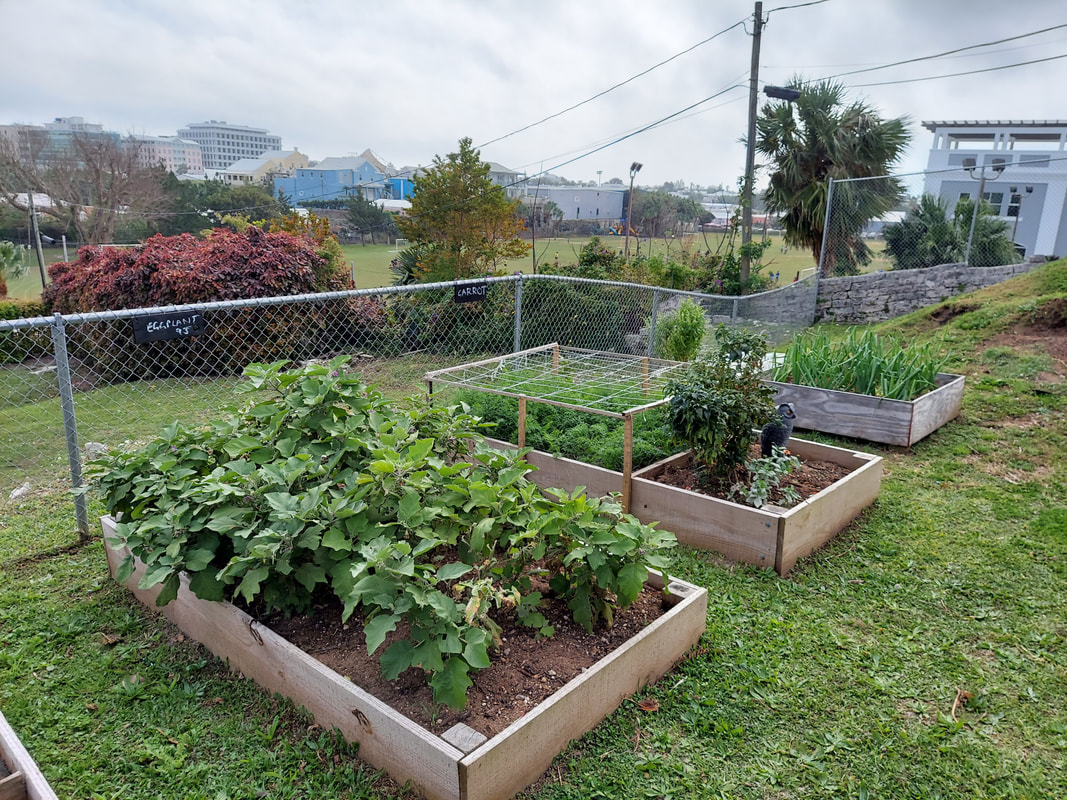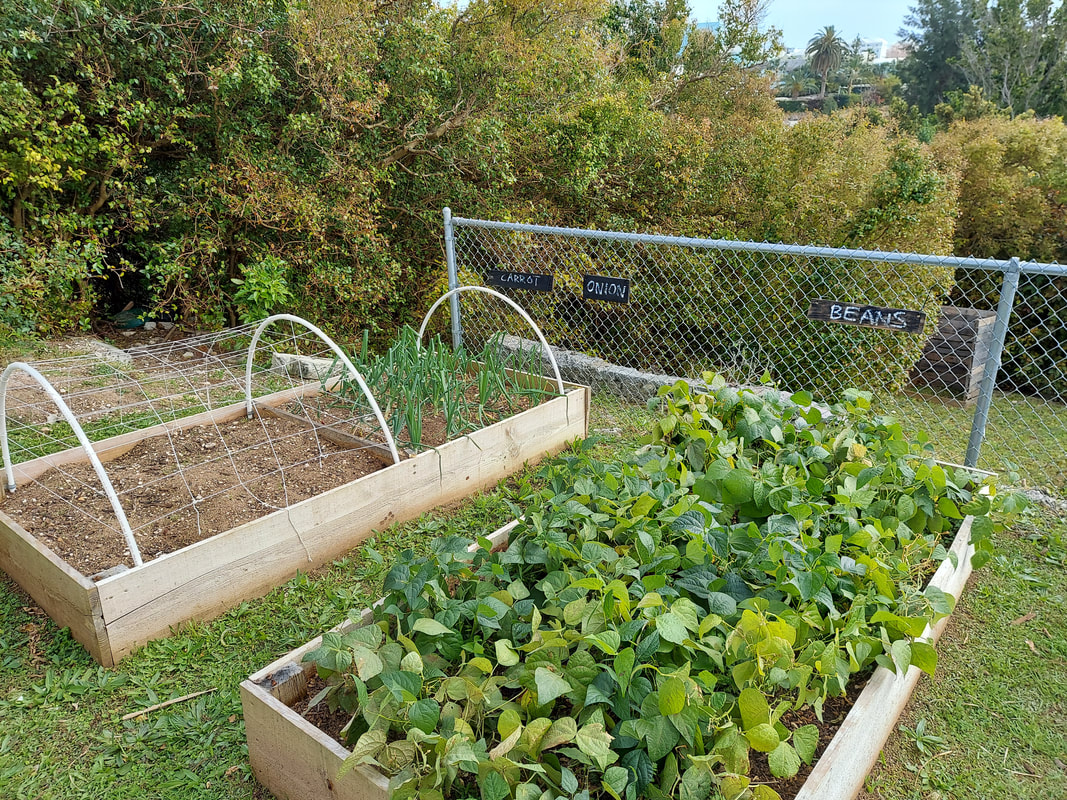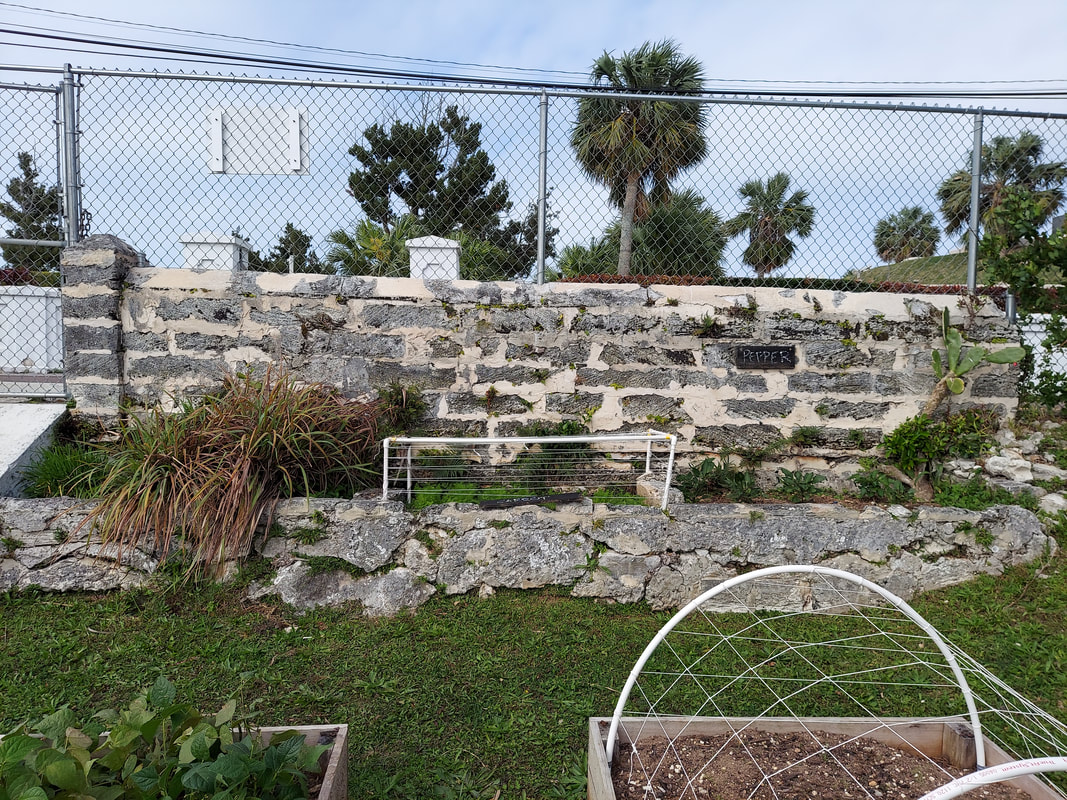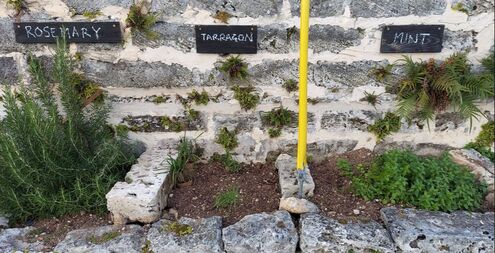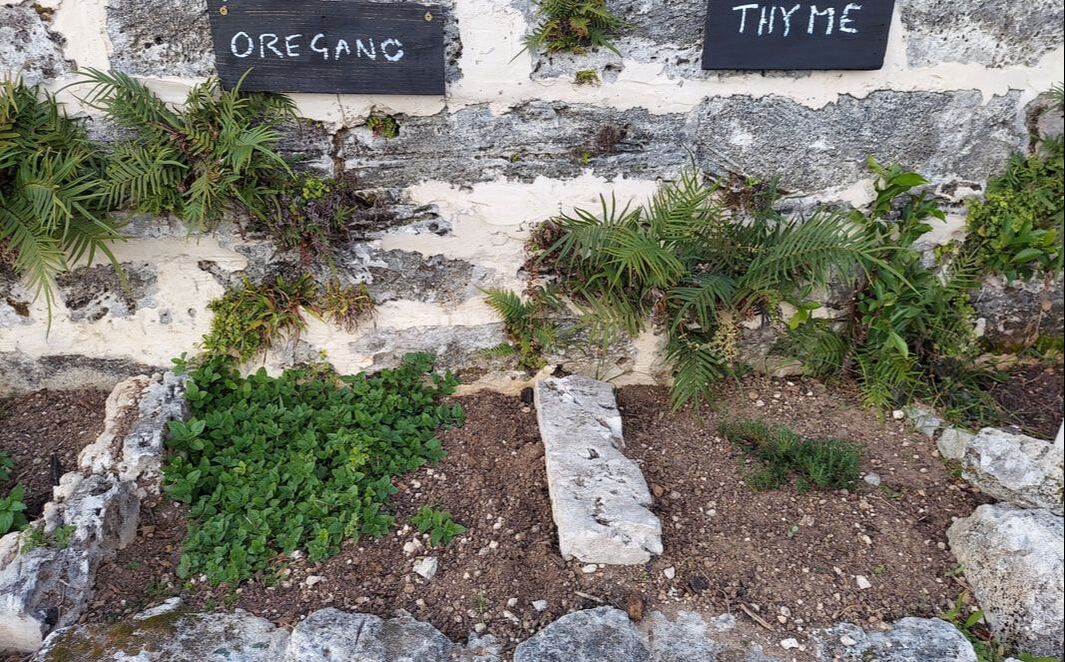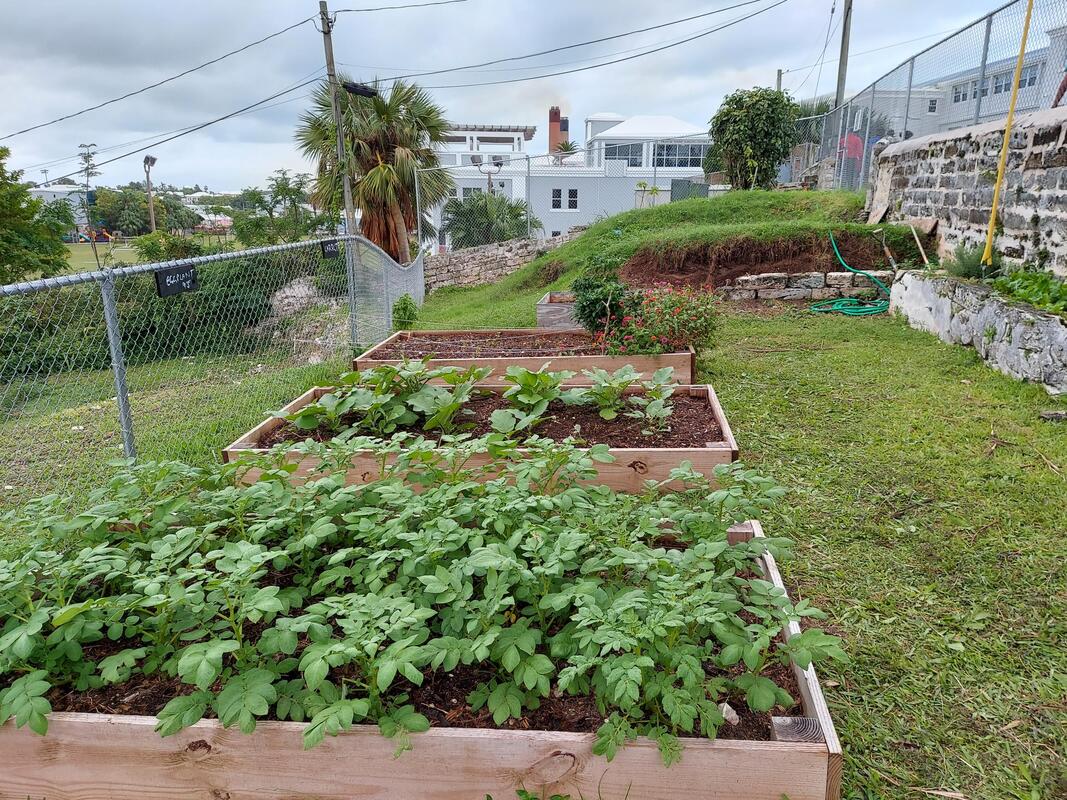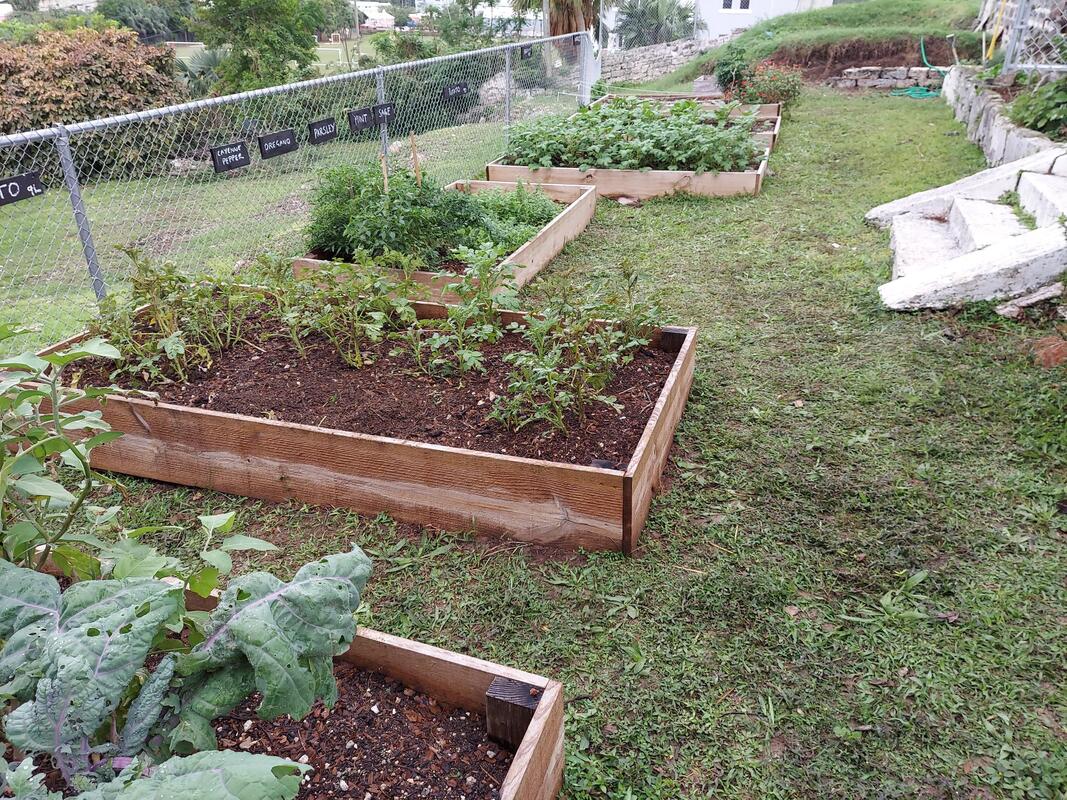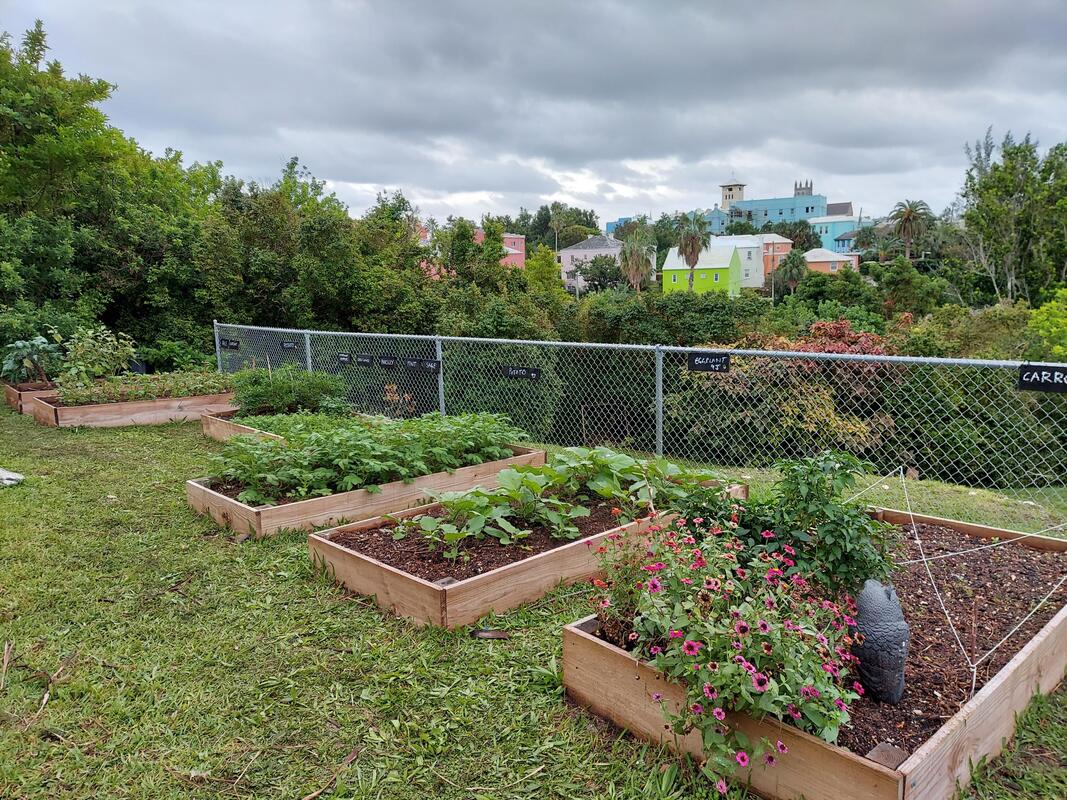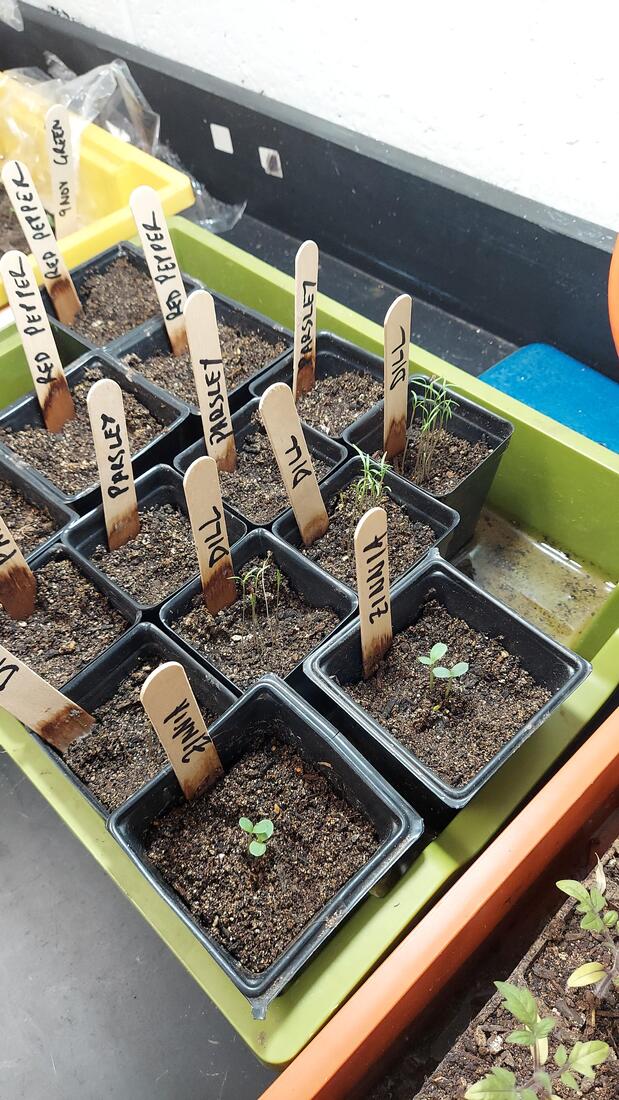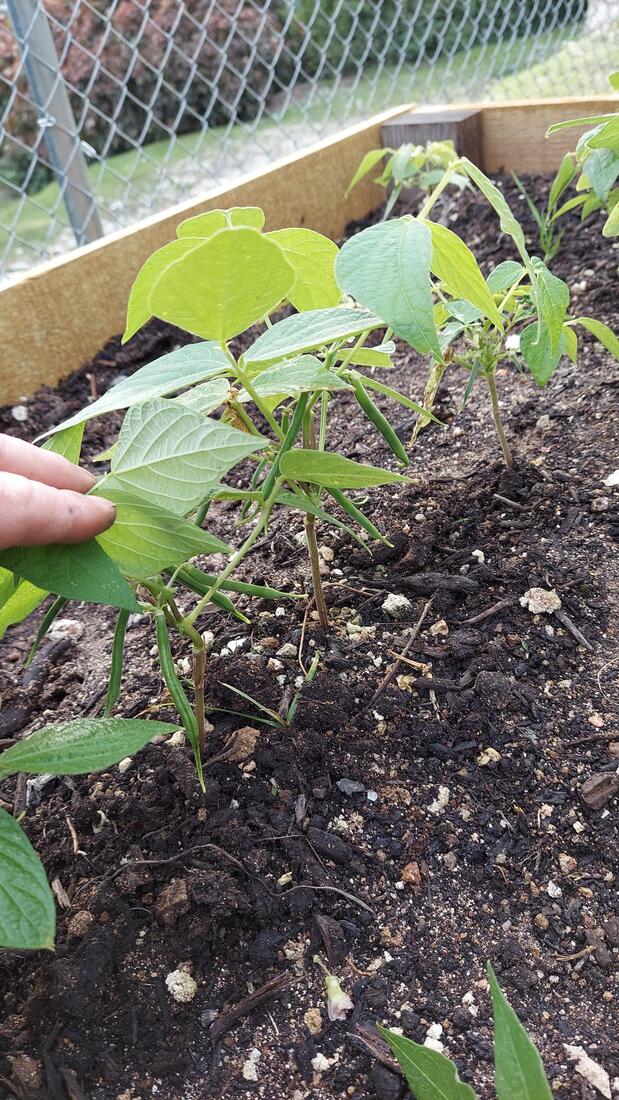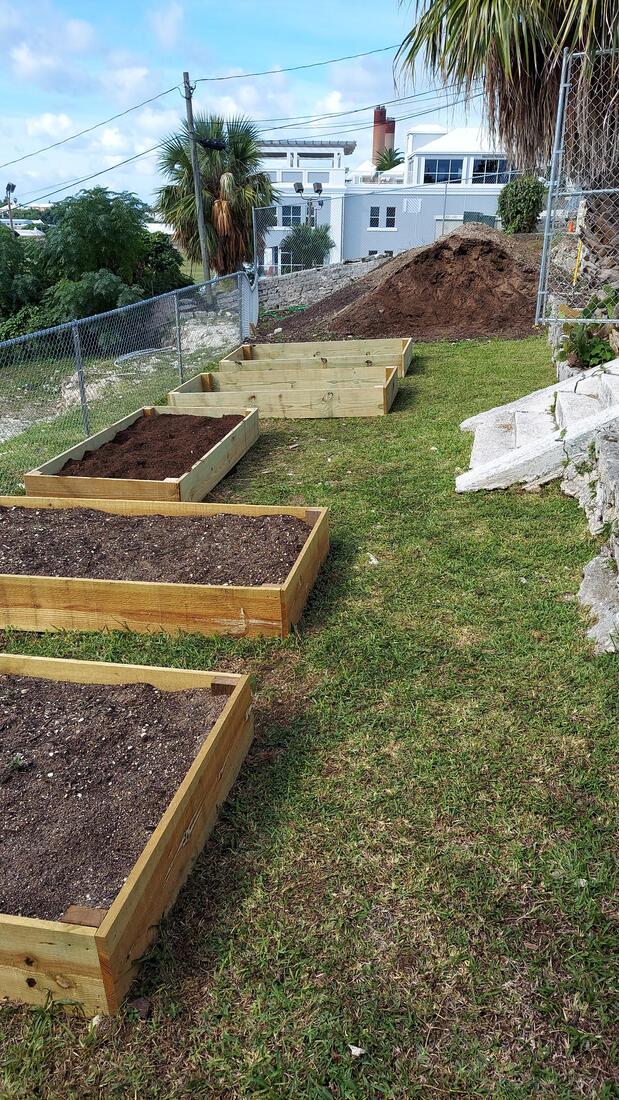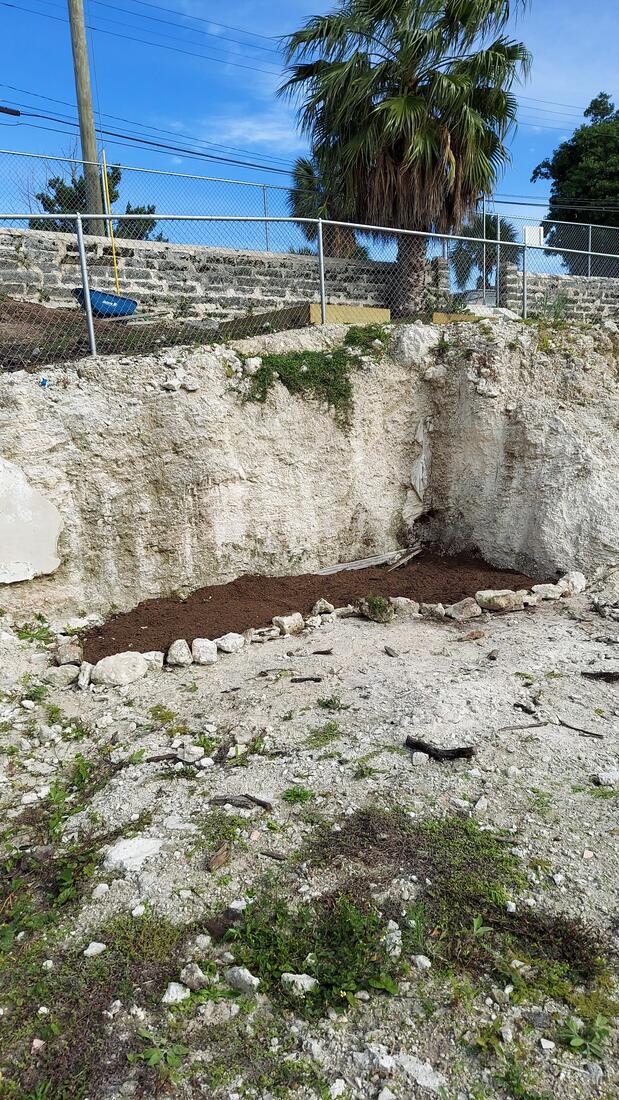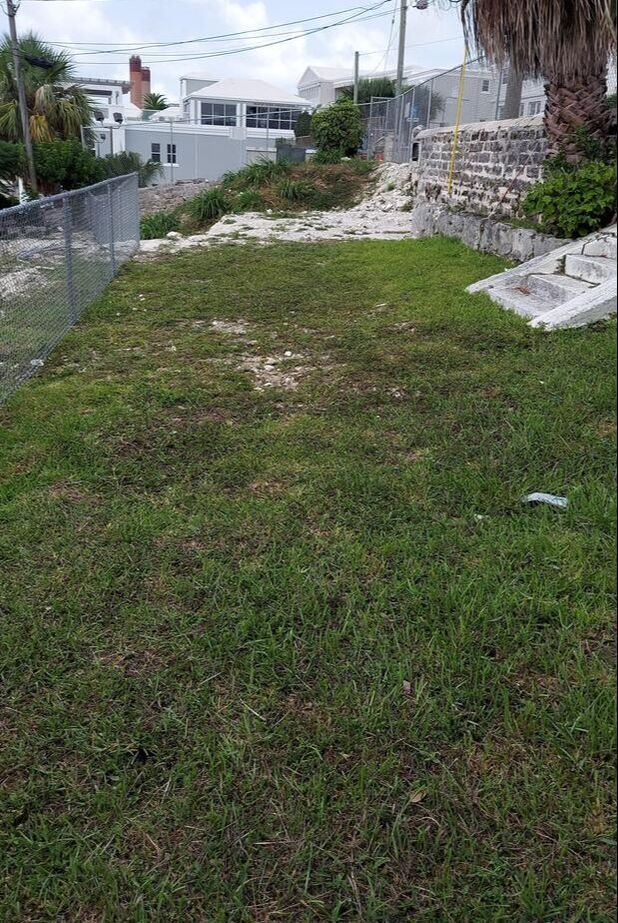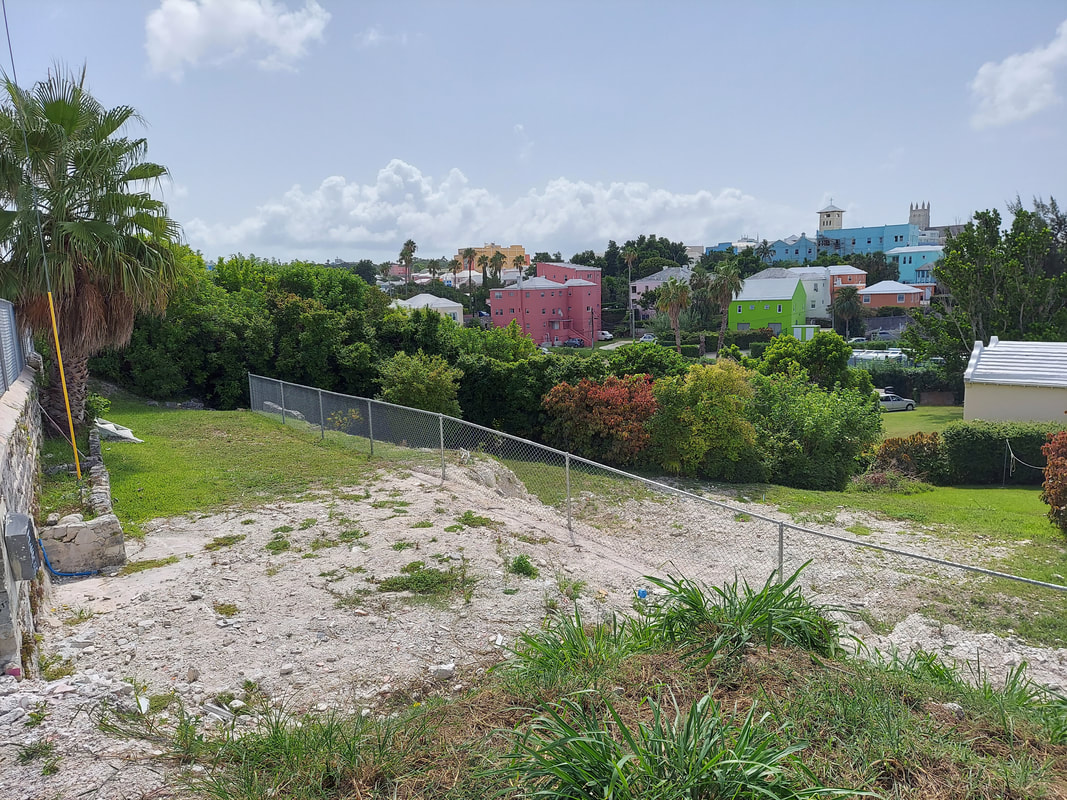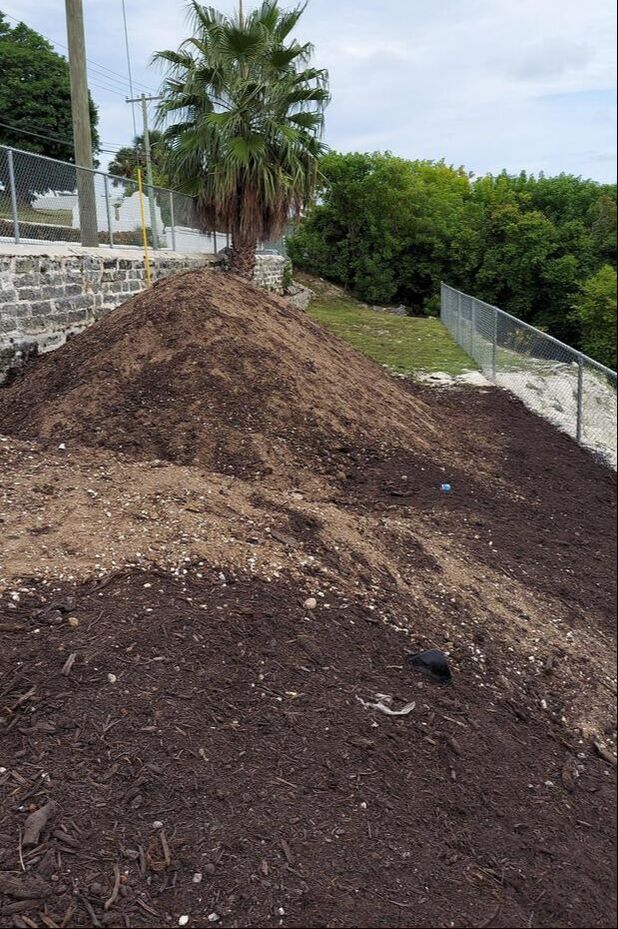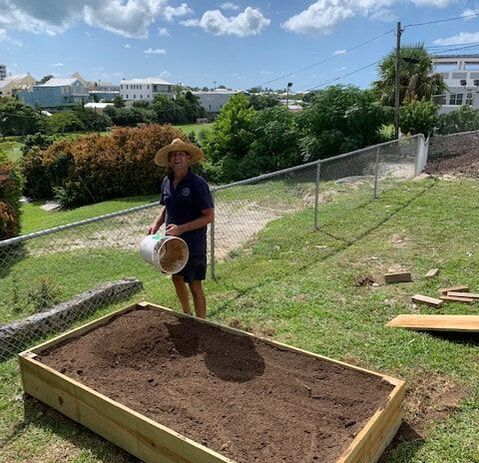Spring 2023
Lots of progress has been made this term. As beds were harvested and emptied, they were subdivided into two or three smaller sections. The idea is that a student or member of staff would take 'ownership' of a section and grow whatever they want. This has started to take hold with one other teacher growing beets and romaine lettuce and various students growing beans, potatoes, beets and carrots. The garden is starting to get noticed and several members of staff took the opportunity recently to avail themselves of the beans. The herbs have been relocated to the old stone boxes, which have been subdivided using spare blocks of limestone. This opens up larger space in the beds for the main crops. Herbs: rosemary, tarragon, thyme, mint, oregano and parsley, with lots of basil growing by the clifftop fence. The key to growing carrots is to build PVC hoops and netting to keep the wretched chickens at bay. The feral cat also has a habit of digging up some beds. Onions and eggplants are growing really well this year.
Autumn 2022
More crops... 9J planted eggplant seedlings and some chitted local potatoes. 9L planted some chitted golden potatoes from Idaho. Both were growing well, until early November when 9L's golden potatoes all died over a period of about a week. We think that it was blight. Teachable moment about food dependency and the importance of a diverse crop. Photos taken for the interschool garden competition. Herbs continuing to swamp Bed 3. A donation of 5 large bags of horse manure was gratefully received and dug into the empty beds and allowed to rot down for a month before planting. Hurricane Fiona in Septermber wiped out all of the tomato and basil plants.
Summer 2022
After several successful harvests, the heat of the summer has badly affected the crops that remain. The yellow squash and zuchinni were doing well and produced a few great fruits before succombing to mold. The butternut squash did amazingly, with over 20 decent sized and tasty gourds harvested over the year. The landscapers came in to mow the grass and wiped out the remaining plants, leaving the gourds behind at least...
Several self-seeded tomatoes are growing well and three eggplants are ripening steadily. Kale is doing well as are the various herbs. I relocated the mint from the square foot garden to the herb garden. Some animal keeps digging up the corn seedlings. Mr Tuna's potatoes finally sprouted after two months, but only a handful of them. During the early part of July, I moved over 25 wheelbarrows of soil from the heap to the lower level to cover the rubble. Many loose rocks were removed and cardboard laid down (no-dig) first to reduce soil loss and supress weeds. This will be grassed over naturally until we come up with a plan.
Several self-seeded tomatoes are growing well and three eggplants are ripening steadily. Kale is doing well as are the various herbs. I relocated the mint from the square foot garden to the herb garden. Some animal keeps digging up the corn seedlings. Mr Tuna's potatoes finally sprouted after two months, but only a handful of them. During the early part of July, I moved over 25 wheelbarrows of soil from the heap to the lower level to cover the rubble. Many loose rocks were removed and cardboard laid down (no-dig) first to reduce soil loss and supress weeds. This will be grassed over naturally until we come up with a plan.
Spring 2022
The garden is going well this spring. Students harvested the potatoes, radishes, lettuces and beans. The tomatoes are slowing growing and bearing fruit. The carrots are now looking like baby carrots. After a few false starts the beets are well established. Kale, eggplant and zucchini have been planted from seeds directly sewn in the beds. A new crop of potatoes was planted, this time the soil was better prepared with composted material from Marsh Folly and horse manure collected from the railway trail. Beans were planted in the last bed along with onions. So currently the state of play as of the end of February 2022
Bed |
Planted |
Comments |
1 |
Onions Kale Eggplant |
Once the potatoes were harvested, more Marsh Folly compost was dug in and onion seedlings were transplanted. All are established. Kale and eggplant were direct sown. The eggplant seedlings have suffered (chickens?) but the kale is going well. |
2 |
Beans Radish |
The beans planted in October are still producing beans and all is going well. Several have died and I suspect that it will soon be time to call it quits and dig them in. The radishes were planted in January and growing well. |
3 |
Peppers Parsley Dill Basil Sage |
This was intended to be the herb garden, but only the sage has thrived from seeds. Have planted seedlings of the other plants. One dill died, but the other is well established. Added more compost to the soil. |
4 |
Lettuce Beets Carrots Spinach |
The salad bed is going well. Carrots and beets have been a struggle, but are well on their way. Spinach has suffered from the chickens. |
5 |
Potatoes |
Better prepared bed, manure and compost added. Idaho potatoes from the supermarket, left to chit and sliced up. Going well at the moment. |
6 |
Bush beans Onions Pepper Potatoes |
This bed has become the one that left over plants seem to end up in! Several spare onions and potatoes were planted. Tamara planted loads of beans. This time we planted them much closer together. One of the two peppers was munched. |
Stone Planters |
Tomatoes Basil Lemongrass Chives Rosemary Peas |
Tomatoes are steadily growing, some have fruits. Basil has taken hold and well established. Lemongrass and Chives are booming. Rosemary is rather sad and barely hanging on. Taller tomatoes have been supported by stakes and strings. Weeds thriving as well. |
Mound |
Squash |
Mixed success. Heavy rain caused leaves to go moldy and die. Most plants looking rather sad. |
Slope area |
Zucchini |
Planted late January - 9/9 successful. Adult leaves |
The herbs sown in Bed 3 have struggled. The basil germinated but got munched. The parsley and oregano didn't germinate. The sage and dill appear to be established and growing slowly. The original mound of soil has been halved as the beds were filled, the rubble area now has a layer of soil on it and grass sown. I used some blocks of stone to form a simple edge to the working area. A couple of year 9 students planted butternut squash on the original mound at the far end and on the top of the remaining soil pile that is being held in reserve. Currently there are 12 squash plants that seem to be well established.
I am hoping to get some students involved after school or during the X-block periods to tend to the garden and take ownership of certain plants or beds.
I am hoping to get some students involved after school or during the X-block periods to tend to the garden and take ownership of certain plants or beds.
Autumn 2021
Starting from a clean slate has proved to be a challenge! Plants take ages to grow from seeds. Tamara was the first to plant, sowing Bed 1 with a batch of sprouted potatoes from Wadson's Farm. They grew quickly and by Christmas were showing signs of being close to harvest. She looked online and found out how to plant them and when to 'earth them up' by mounded more soil around their stems to allow more potatoes to grow. Next up was bush beans. These were planted in two batches, one by me in Bed 2 and another by the senior year students led by Will and Kyle in Bed 5. They had an interesting time as they piled loads of beans into each hole in the rows that they created, and all of them germinated. So a few weeks after sowing they dug them up, separated them and replanted them in Bed 6. These beans have struggled quite a bit. The chief culprits being a couple of black chickens.
Bed 4 was planted out with beets, lettuce, radishes and carrots by year 9 and 10 students. By the end of term, the lettuce and beets were doing well until the chickens decimated them. The radishes and carrots are steadily growing. Tomatoes were grown from seeds and transplanted at the beginning of November into the stone beds. They are steadily but slowly growing. Tamara planted more peas at the far end and they are thriving. Next term she will need to provide vertical support for these as they grow taller. My beans started being harvested at the start of the christmas vacation! In the prep room we have trays of seedlings that are growing very, very slowly. The rosemary and oregano took a few attempts to get started. The peppers, tomatoes and beets are doing well. Hopefully, the year 9 and 10 students can transplant these into the garden in January.
Bed 4 was planted out with beets, lettuce, radishes and carrots by year 9 and 10 students. By the end of term, the lettuce and beets were doing well until the chickens decimated them. The radishes and carrots are steadily growing. Tomatoes were grown from seeds and transplanted at the beginning of November into the stone beds. They are steadily but slowly growing. Tamara planted more peas at the far end and they are thriving. Next term she will need to provide vertical support for these as they grow taller. My beans started being harvested at the start of the christmas vacation! In the prep room we have trays of seedlings that are growing very, very slowly. The rosemary and oregano took a few attempts to get started. The peppers, tomatoes and beets are doing well. Hopefully, the year 9 and 10 students can transplant these into the garden in January.
Summer 2021
During the 2021 school year, Saltus bought the land and house next to the school gate. The house was in poor condition and therefore demolished. The house was built into a hillside and there were two gardens on different levels. After the demolition, the two levels were separated by a 6' cliff. Most of the lower level and half the upper level was bare rock or rubble.
The head suggested that as the area was unsightly and unlikely to used for anything else in the foreseeable future, that the school should create a community garden to help student appreciate food sustainability and the problems that farmers often face. Where possible it will be fitted into the curriculum. It was decided to start the project on the upper level, at least until things were established. Water was available from the school well, so a pipeline and hose were installed. A fence was installed above the cliff to prevent students falling off. A mixture of barren topsoil and composted vegetation from the Marsh Folly site was trucked in at the beginning of September, just in time for Saltus going remote due to a Covid case during the staff meetings! This helped to give time for the still hot pile of material to cool down.
The head suggested that as the area was unsightly and unlikely to used for anything else in the foreseeable future, that the school should create a community garden to help student appreciate food sustainability and the problems that farmers often face. Where possible it will be fitted into the curriculum. It was decided to start the project on the upper level, at least until things were established. Water was available from the school well, so a pipeline and hose were installed. A fence was installed above the cliff to prevent students falling off. A mixture of barren topsoil and composted vegetation from the Marsh Folly site was trucked in at the beginning of September, just in time for Saltus going remote due to a Covid case during the staff meetings! This helped to give time for the still hot pile of material to cool down.
|
Building the Raised Beds
As the soil was very thin and just covering the bare limestone that makes up Bermuda, it was decided to build six raised beds to start the project. These were 8' x 4' x 1' and built using treated lumber. There was a debate about using treated wood, with the general opinion that the preservatives would not be a problem. The hardest part of building the beds was cutting the timber to the right size. After that, assembly was easy and the sides were screwed into the corner blocks. As the ground was very uneven, some levelling work was needed. |
Filling the beds was by far the hardest task! The bed's capacity is 32 cubic feet of soil each. That was a lot of soil to move. The first three beds were done by bucket, after that the maintenance guys at school lent me a wheel barrow, which took some of the manual labour out of the task. With hindsight, I should have sifted some of the soil as I filled the beds, but this would have made an already long tiring job even longer and more tiring. Later, I did sift the upper layers of soil in each bed. By mid-December, Mr Nannini had sourced some organic fertiliser/manure and he added that to the soil. As larger bits of wood and rock were found, they were removed and thrown over the fence on top of the bare rubble below. Eventually, this will form soil as it rots.
